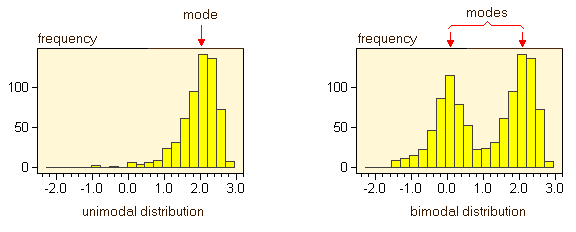| Fundamentals of Statistics contains material of various lectures and courses of H. Lohninger on statistics, data analysis and chemometrics......click here for more. |

|

Home  Univariate Data Univariate Data  Measures of Location Measures of Location  Mode Mode |
|||||||||||
| See also: median, mean | |||||||||||
Mode of a DistributionThe mode is the value which occurs most frequently in a data set. The mode is only of interest for large data sets, as in small samples the mode strongly depends on random variations of the data. The term "mode" is contained in the expressions "unimodal", "bimodal", and "multimodal". Distributions showing only a single peak are called unimodal, bimodal distributions show two peaks in their frequency diagrams. The relative position of the mode, the median, and the mean provides an indication of the skewness of a distribution. Click on the figure above to see an example of differently skewed distributions. The calculation of the mode D of classed data with equal bin widths (as in histograms) can be done according to the following equation:
|
|||||||||||
Home  Univariate Data Univariate Data  Measures of Location Measures of Location  Mode Mode |
|||||||||||



